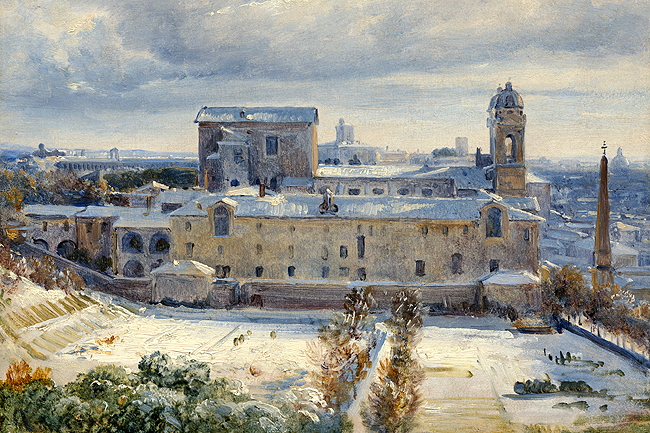ARTS-PAINTINGS: 19th-Century oil sketches at the National Gallery of Art Washington
Trinità dei Monti in the Snow’ (1825/1830) André Giroux Santa. Oil on paper, mounted on canvas. PHOTO: NATIONAL GALLERY OF ART, WASHINGTON
.

THE WASHINGTON POST – Could it be that one of the most important things going on in the United States’ (US) capital recently was a modest display of 19th-Century oil sketches at the National Gallery of Art?
Call me crazy, but I went to bed recently thinking it might be. Catching up with the latest headlines over coffee the next morning, I laughed at my earnest folly. Clearly, I thought, I’ve spent too many years as an art critic, inflating art’s importance relative to real lives, real politics.
And yet, weeks have now passed and I’m returning to my original estimation. This show, I’m convinced, matters deeply.
It sounds absurdly minor. It’s about how a bunch of European painters started paying close attention to empirical reality (remember that?) and how, one by one, they figured out how to set aside convention and prejudice, and to paint what was before their eyes.
This began in the late 1770s – almost a century before the first Impressionist exhibition. It was practiced at first by artists you’ve likely never heard of: Achille-Etna Michallon, André Giroux, Francois-Marius Granet, Jules Coignet and Jean-Jospeh-Xavier Bidauld. Their ways caught on quickly, though, so that, by the 1820s, landscape artists whose names we do know – Camille Corot, Richard Parkes Bonington, John Constable – were working the same way. And by the 1830s, almost every landscape painter was doing it.
.
Ads by: Memento Maxima Digital Marketing
@ [email protected]
– SPACE RESERVE FOR YOUR ADVERTISEMENT
– SPACE RESERVE FOR YOUR ADVERTISEMENT
.

Ads by: Memento Maxima Digital Marketing
@ [email protected]
– SPACE RESERVE FOR YOUR ADVERTISEMENT

– SPACE RESERVE FOR YOUR ADVERTISEMENT
.

Ads by: Memento Maxima Digital Marketing
@ [email protected]
– SPACE RESERVE FOR YOUR ADVERTISEMENT

– SPACE RESERVE FOR YOUR ADVERTISEMENT
.

Ads by: Memento Maxima Digital Marketing
@ [email protected]
– SPACE RESERVE FOR YOUR ADVERTISEMENT

– SPACE RESERVE FOR YOUR ADVERTISEMENT
.

Ads by: Memento Maxima Digital Marketing
@ [email protected]
– SPACE RESERVE FOR YOUR ADVERTISEMENT

– SPACE RESERVE FOR YOUR ADVERTISEMENT
.
If it was a craze, its watermark was modesty. These paintings were not made to be sold or even shown outside a small circle of fellow painters. The National Gallery exhibition, organised by Mary Morton, Jane Munro and Ger Luijten, unites works from four collections (including the NGA’s), and builds on a steady drizzle of discovery, scholarship, exhibitions and publications over half a century.
So it’s modest. Yet for all its quietude, the show is radical. And so intensely beautiful. You walk in and … wow! If you have any capacity for feeling, you gasp. Fresh snow on the roof and grounds of Rome’s Trinita dei Monti church, as seen through a window of the Villa Medici. Gorgeous! Warm sun illuminating the buildings and bridges on the island of San Bartolomeo. Oh! Vesuvius in the distant haze, beyond the backlit buildings of Naples. … The effect of light rinsing the eyes, of freshness and immediacy, of truth – it shouldn’t be so striking, so unaccountably emotional. But it is.
Why? Is it the authenticity? Does painting as fresh and firsthand as this provide the antidote we need to screens, social media and the capital’s all-around ambiance of lies and spin? Could be. But I think these small, luminous paintings are pressing us into an awareness of something deeper.
The fact is that we’re being pulled ever further from an awareness of our minds’ basis in, and dependence on, nature, and from the idea that there exists an empirical reality. That’s scary. You can point to the subjectivity and partiality of vision all you like. (We’re all limited in our perceptions. To be human is to struggle with bias). But when you’re so obsessed with exposing bias that you abandon the idea of an empirical reality altogether, you leave a vacuum.
Reality, at that point, becomes biddable. And when that happens, it’s always the power-mad, the manipulative, the greedy, the delusional who bid highest, who swarm into the vacuum, who impose their own self-serving reality on everyone else.
.
Ads by: Memento Maxima Digital Marketing
@ [email protected]
– SPACE RESERVE FOR YOUR ADVERTISEMENT
– SPACE RESERVE FOR YOUR ADVERTISEMENT
.
This show stands up for empirical reality.
At the time the practices of these painters took hold, it was understood among artists that there were two ways to depict nature: as it was in reality or “as it should be”. Painting nature “as it should be” – idealised, ennobled, illustrative of received ideas and underlying morals – was very much the preferred option.
But painting is not easy. And before it can be “idealised,” nature has a lot to teach every artist. So at the end of the 18th Century, some artists visiting Italy from farther north in Europe, thrilling to the Italian light and to their sense – induced by the ruins of the Roman Empire – of nature as an enduring witness to human folly, began making sketches in oil paints of what they saw around them. A view of rooftops out the window. A sun-kissed wall in Naples. A gushing waterfall. A crumbling ruin. Distant trees emerging from the mist.
Inspired by a widely read manual by a mostly forgotten figure, Pierre-Henri Valenciennes, they worked on paper which they pinned to their paint boxes. They painted directly in oils, mostly without under-drawing. If they took Valenciennes’s advice, they spent no more than a couple of hours on these “sketches”. Many refined their paintings back in the studio. But they never intended the results for exhibition. In fact, most of these works were destroyed. Those that survived were rarely signed.
.
Ads by: Memento Maxima Digital Marketing
@ [email protected]
– SPACE RESERVE FOR YOUR ADVERTISEMENT
– SPACE RESERVE FOR YOUR ADVERTISEMENT
Some of these oil sketches were used as aides mémoires or as studies for bigger paintings. But just as often they were done as exercises, for pleasure, or both.
None of which sounds remarkable now. Painting en plein-air – in the open air – has been commonplace for almost 200 years. But everything begins somewhere. Registering this, you have to ask why, and what it meant.
In art, it’s always fascinating to see how strong the collective conventions that govern vision can be, and how seriously they can impede our ability to see clearly. When Europeans first came to America, for instance, or to Australia, they spent decades painting the distinctive new landscapes they encountered – landscapes that looked nothing like Europe – as if they were just another version of Europe.
Their visions were dictated by the conventions they brought with them. As examples of bias, of cognitive dissonance, the results are interesting. But they’re also absurd, stale, embarrassing – in the same way that seeing the world through the lens of your social media feed is absurd, stale, embarrassing.
Yet the same few decades that saw Americans achieve independence from Britain, Australia settled by convicts, the French Revolution and the rise and fall of Napoleon also saw something quietly changing in the history of representation. First in Italy, then in England and France and all over Europe.
.
Ads by: Memento Maxima Digital Marketing
@ [email protected]
– SPACE RESERVE FOR YOUR ADVERTISEMENT
– SPACE RESERVE FOR YOUR ADVERTISEMENT
.
It would be easy to say that it was exclusively to do with a new, disinterested idea of objective truth – the same impulse that informed the Enlightenment and the scientific revolution. But to look at these paintings is to realise that the painters who made them were not merely “gathering objective data”.
They were drawing also on feeling. They were almost all informed by what the late curator Philip Conisbee (a key figure in their rediscovery) called “a tender and loving regard for the world.”
So it was never a question “of some naive and literal-minded transcription of the thing seen”, as Conisbee put it. This new way of painting reflected something deeper, something inherently poetical. An apprehension of the beneficence of nature.
These artists were being true to a strand of the Enlightenment which can be neatly encapsulated in a single name: Jean-Jacques Rousseau. In Emile, his 1762 treatise on education, Rousseau provided a philosophical foundation for the works in True to Nature. Addressing the question of how to educate a child, he insisted on the importance not just of drawing, but drawing from life. The child Emile, he wrote, “shall have no master but Nature, and no models but objects. … He shall draw a house from a house, a tree from a tree, a man from a man.”
.
Ads by: Memento Maxima Digital Marketing
@ [email protected]
– SPACE RESERVE FOR YOUR ADVERTISEMENT
– SPACE RESERVE FOR YOUR ADVERTISEMENT
.
In other words: Don’t accept received wisdom. Dispense with acquired habits. Find out for yourself. Look. Look with feeling. Look again.
In a key passage, Rousseau wrote: “I prefer to have (Emile) show me the plant acanthus” – a plant known for growing among the ruins of Rome – “even though he be less skillful in tracing the foliage of a capital (ie of a Corinthian column).”
True to Nature is all about a moment in history when, amid the fallen Corinthian capitals of Rome, painters began noticing species of thistle, unique cloud formations, types of bark and coastal rock, views through windows, overlooked patches of sand and weed, and sunlight on rocks. They painted all this not only with a growing sense of fidelity to empirical reality but with a relish for the pleasures of oil paint, atmospheric conditions and active, engaged observation.
The example they set, like Rousseau’s advice in Emile, applies not just to artists and students. It’s a cornerstone of journalism, scientific inquiry and poetry. It’s an instruction for how to be in the world. It has never been more important./ Sebastian Smee
REF: https://borneobulletin.com.bn/these-artists-painted-reality-in-a-way-weve-lost-sight-of/
.
All photographs, news, editorials, opinions, information, data, others have been taken from the Internet For comments, Email to : Golden Hand Arts Club | Contributor









